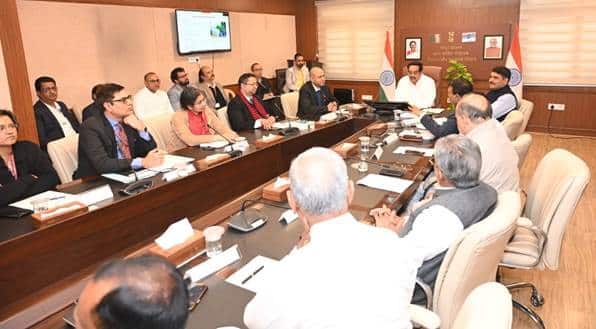Gujarat’s Green Energy Initiative: CBG Production

In a significant move towards sustainable energy, Union Minister for Jal Shakti, Shri C R Patil, convened a pivotal meeting with leaders from Gujarat’s dairy cooperatives and dairies. The primary focus of this meeting was to accelerate the establishment of Compressed Biogas (CBG) plants. These plants will convert cattle dung and other organic waste into sustainable energy and organic manure. This initiative aligns with the government’s vision of transforming waste into wealth, promoting both environmental sustainability and economic growth.
The Role of Dairy in Sustainable Energy
During the meeting, Shri Patil highlighted the dairy sector’s essential role in enhancing energy efficiency and sustainability. He pointed out that by converting organic waste from dairy operations into CBG, Gujarat stands to gain both environmentally and economically. This initiative promises a significant reduction in carbon emissions while fostering self-sustaining energy models in rural areas. The Minister emphasized that India’s dairy sector has been a cornerstone of rural livelihoods. By adopting green technologies like CBG production, the sector can reduce its carbon footprint and create new revenue streams for farmers and cooperatives. This includes the potential to earn carbon credits, which can further incentivize the adoption of sustainable practices.
The dairy industry in Gujarat is poised to play a crucial role in this green energy transition. The conversion of organic waste into CBG not only addresses waste management issues but also contributes to energy self-sufficiency. This dual benefit makes the initiative a win-win for both the environment and the economy. As the dairy sector embraces these green technologies, it can lead to a more sustainable future for rural communities in Gujarat and beyond.
Gujarat’s Untapped Potential for CBG Production
Gujarat has a vast potential for CBG production, primarily due to its large bovine population. According to the 2019 Livestock Census, the state is home to approximately 2.01 crore cattle, generating an estimated 2 lakh tons of cattle dung daily. This presents a tremendous opportunity for the state to produce around 4,000 tonnes of CBG per day. Such production could significantly boost the green energy sector in the region.
The meeting underscored the importance of leveraging this potential. By utilizing cattle waste and other organic materials for bio-CBG production, Gujarat can lead the way in renewable energy initiatives. The state government is committed to establishing over 20 CBG plants and more than 30,000 individual biogas units, with an estimated investment exceeding 1,000 crores. This ambitious plan aims to position Gujarat as a model state for integrating clean energy practices within the dairy sector.
The enthusiasm among cooperative leaders during the meeting was palpable. Many expressed their willingness to support and adopt eco-friendly initiatives. This collective commitment is crucial for the successful implementation of CBG production and the broader goals of energy sustainability.
Key Highlights and Future Directions
The meeting included several key highlights that outline the path forward for Gujarat’s CBG initiative. Detailed discussions focused on how to effectively leverage cattle waste and other organic materials for bio-CBG production. There was also an exploration of potential partnerships between cooperatives, private entities, and government agencies. These partnerships aim to facilitate funding and technology transfers, which are essential for the successful establishment of CBG plants.
Moreover, the government has committed to providing technical and financial support under existing schemes for bio-energy projects. This support is vital for ensuring that the dairy sector can transition smoothly to greener practices. The focus on establishing Gujarat as a model state for clean energy practices in the dairy sector is a significant step towards achieving India’s energy and sustainability goals.
The meeting also saw participation from senior officials across various departments, including Fertilizers, Animal Husbandry, and Renewable Energy. Their involvement underscores the government’s commitment to promoting renewable energy and supporting innovative models for sustainable development. As stakeholders collaborate and leverage government schemes, the dairy industry is set to become a key player in India’s green revolution.
Observer Voice is the one stop site for National, International news, Sports, Editor’s Choice, Art/culture contents, Quotes and much more. We also cover historical contents. Historical contents includes World History, Indian History, and what happened today. The website also covers Entertainment across the India and World.

